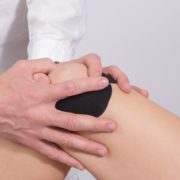Why You Should Avoid a Cortisone Shot in Your Knee (And What to Do Instead)
Knee pain can be debilitating, making simple tasks like walking, climbing stairs, or even standing up a painful experience.
For many, the quick fix seems to be a cortisone shot – an anti-inflammatory injection that offers temporary relief from knee pain. When injected into the knee, the cortisone (a type of steroid) targets the inflamed tissues and aims to reduce the symptoms of pain and swelling.
But there are significant risks and downsides to this approach to resolving knee pain that are often overlooked. Let’s take a look at why you should avoid a cortisone shot in your knee and what you can do instead…
The Problem with Cortisone Shots:
1. Temporary Relief, Not a Cure
Cortisone shots offer pain relief for a limited period, ranging from a few weeks to a few months. The problem? They don’t address the underlying cause of the knee pain. Instead, they mask the symptoms, allowing the root problem – whether it’s osteoarthritis, tendonitis, or a mechanical imbalance in the knee joint – to worsen over time. By numbing the pain, cortisone shots may allow you to continue harmful activities that could exacerbate your condition, leading to long-term damage.
2. Potential for Joint Damage
Since the relief from cortisone shots is temporary – they are often repeated. And repeated cortisone injections can lead to cartilage degeneration and weaken the tendons and ligaments in your knee. Studies have shown that frequent cortisone use can accelerate the wear-and-tear process, potentially hastening the need for knee replacement surgery down the line. This is particularly alarming for active individuals who are hoping to preserve their knees for as long as possible so they can keep doing all the activities they love and enjoy.
3. Delayed Healing
Cortisone’s anti-inflammatory effects can actually interfere with the body’s natural healing processes. Inflammation, while uncomfortable, is an essential part of how the body repairs itself. Reducing inflammation with steroids (like cortisone) can disrupt tissue repair, meaning that any existing damage to your knee could take longer to heal. And when you mask your symptoms with cortisone – it makes this even harder to detect.
4. Risks of Infection and Other Side Effects
Like any injection, cortisone shots come with the risk of infection. Additionally, they may cause side effects such as increased blood sugar levels, skin thinning, or changes in pigmentation around the injection site. While these risks may seem minimal to some, they should be weighed carefully against the short-term benefits of temporary pain relief.
So… What Should You Do Instead?
I’m a huge fan of natural treatments whenever possible. And when it comes to knee pain, there are plenty of natural alternatives that not only promote healing , but address the root cause of your knee pain – allowing for more long-term relief instead of short-term.
1. Shockwave Therapy
Shockwave therapy is a non-invasive treatment that uses acoustic sound waves to stimulate the body’s natural healing processes. The waves create micro-traumas in the tissues surrounding your knee joint, which triggers increased blood flow and promotes tissue regeneration. Shockwave therapy has been shown to reduce pain, improve mobility, and even help with conditions like calcific tendonitis and knee osteoarthritis.
What’s especially beneficial about shockwave therapy is that it not only reduces pain but also works to heal the damaged tissues. Unlike cortisone shots, which only offer symptom relief and can even damage tissue, shockwave therapy targets the underlying problem, making it a great option for those looking to fix their knee pain for the long term.
2. Dry Needling
Dry needling is another natural treatment that can help alleviate knee pain by targeting trigger points in the muscles around the joint. This technique involves inserting thin needles in and around your knee joint to release tension and improve blood flow. By relieving muscle tightness, dry needling helps restore proper alignment and function in your knee joint, reducing pain and preventing further injury.
This approach works particularly well for those with knee pain caused by muscle imbalances, tendonitis, or chronic stiffness. Since dry needling promotes muscle relaxation and better circulation, it helps the knee heal from within, supporting long-term recovery.
3. Work with a Mechanical Knee Pain Specialist
A mechanical knee pain specialist is a healthcare professional trained to assess and diagnose the root cause of your knee pain through specialized movement analysis. Unlike traditional healthcare providers who may prescribe pain relief or general exercises without fully understanding the mechanics of your knee, mechanical pain specialists take a deep dive into how your body moves. By pinpointing issues such as improper joint alignment, muscle imbalances, or overuse patterns, they can design a customized treatment plan to address the root cause of your pain, versus just chasing symptoms.
The key benefit of working with a mechanical knee pain specialist is that they focus on the underlying biomechanics of your knee as well as surrounding joints/muscle groups that may be contributing to your pain. It’s a more holistic approach designed to restore normal function in your knee joint, alleviate pain, and teach you how to prevent future injuries as well.
While a cortisone shot is routinely recommended by medical doctors, and may offer quick relief, they don’t contribute to the healing process and can, in fact, cause long-term harm.
Opting for natural treatments like shockwave therapy, dry needling, or working with a mechanical knee pain specialist who can often integrate these treatments in with corrective, targeted exercises – has several advantages – and it’s much healthier for your knees. Most importantly, these natural approaches address the root cause of your knee pain rather than just masking it.
If you’re suffering from knee pain, and need help finding reputable healthcare providers in your area who can offer these natural treatment alternatives with success and expertise – reach out – we can help direct you toward what to look for – and what to watch out for.
Are you local to Portsmouth, NH? If so, consider speaking to one of my specialists in a free Discovery Session. This 30-min session is a designed to: 1. Make sure we can help you 2. Make sure you’re a good fit for what we do 3. Make sure we’re a good fit for you
Dr. Carrie Jose, Physical Therapy Specialist, and Mechanical Knee Pain Expert, owns CJ Physical Therapy & Pilates in Portsmouth and writes for Seacoast Media Group. To get in touch – or request a seat in her upcoming Masterclass to end Knee Pain naturally – without pills, procedures, or surgery – CLICK HERE.



